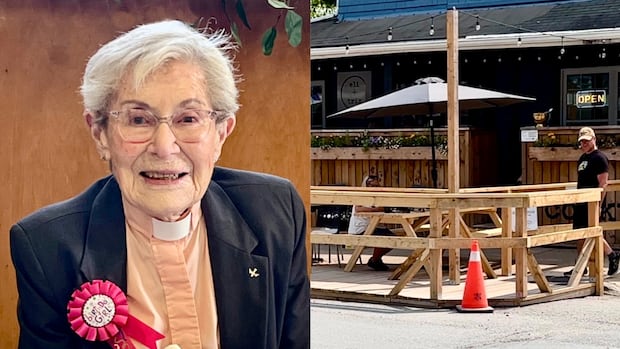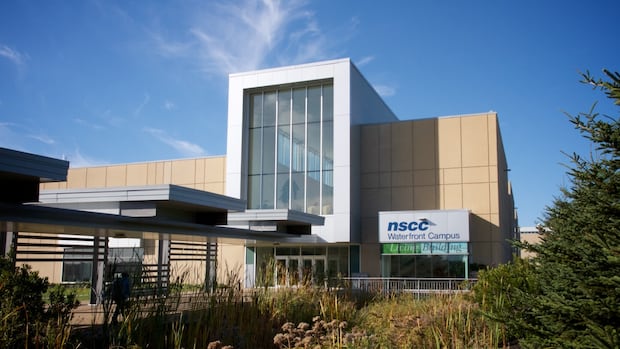Over 200 people are buried in this N.S. cemetery. These women won’t let their names be forgotten

Other than a few upright gravestones, the Hillside Cemetery in Dayspring, N.S., would be easy to miss.
The cemetery is tucked away at the edge of a municipal trail system in the Lunenburg County community, surrounded by a fence to keep it safe and clean.
It’s been there for more than a century, serving as the burial place for more than 200 people, but Yvonne Rafuse only learned of it during the COVID-19 pandemic.
Wanting more exercise, she and her husband started walking the local municipal trails. But when they came upon the cemetery, she was surprised there were no names at the site — just 170 numbered granite stones placed in the ground.
It was disheartening to see, she said.
“These names were given to these people at birth. A lot of these people had families, they had children of their own, they had husbands, wives, parents,” Rafuse said. “I felt that that needed to be recognized, that these were real people and not just numbers.”
The people buried in the cemetery are residents of the Lunenburg Municipal Home or County Home. It has also been referred to as the Lunenburg Municipal Hospital, but that is disputed.
The so-called poor farm was established by the Nova Scotia government in the late 1880s to house people who were poor, physically sick or mentally ill.
The home closed in 1980, but its cemetery is still maintained by the Municipality of the District of Lunenburg.
In 2018, municipal council placed a small plaque and interpretive signage at the site to provide visitors with information about who is buried there and why.
But Rafuse said that’s not enough.

She, along with local genealogy specialist Betty Rhodenizer, want the names of those buried there added to a memorial monument at the site.
The pair spent hours conducting research at the South Shore Genealogical Society and analyzing death records from the home to create a list of names of the people buried at the cemetery.
They found 207 people, and there could still be more.
“We did the research,” Rhodenizer said. “We went all through the records and we picked out all of the folks who were buried here in the cemetery and we’ve made lists of them and [we’re] trying to see what we can do to give these people dignity and recognition.”

So in January, the pair presented their findings to the Municipality of the District of Lunenburg in hopes of getting a monument erected that lists all of their names and the numbered plot where they’re buried.
They suggested that the names of everyone buried in the cemetery be added to a monument at the site. They also want some information at the site to be corrected.
The plaque and interpretive sign say people were buried there between 1904 and 1954, but their research shows the first burial occurred in 1895 and burials continued until at least the 1960s.
It’s a “historic wrong that needs to be righted,” said Rafuse.
“There should be no shame in having lived in the county home — that’s 1950s thinking.”

But in June, a staff report to council suggested a different approach to adding names at the site: a grave marker program.
It would allow relatives of the people buried in the cemetery to purchase a nameplate to be placed on the plot where they’re buried.
But Rafuse and Rhodenizer say that will be complicated.
Some may not have living relatives to come forward. And some plots have multiple people buried in them.
“There’s a possibility of when people do the research, they may find that their ancestor or relative is buried in a grave with some others,” Rafuse said.
“And so it could be a bit of a dilemma in terms of putting a grave marker for one person, especially knowing there may be another person buried in there with them.”

Rafuse said they weren’t consulted on the change.
Mayor Carolyn Bolivar-Getson acknowledges their concerns, but said it should be up to the families to decide.
“If the families want the names there, then we would be more than happy to move forward with that, but the program will be put in place to have the markers that will individually mark the graves of those individuals,” Bolivar-Getson said.
She said if multiple people are buried in the same plot, multiple nameplates can be added.

Bolivar-Getson said details of the new program are being worked out this summer, and staff will be working with the South Shore Genealogical Society to fix any incorrect information at the site.
But Rafuse said she’d like the municipality to reconsider their decision on the plaque.
“We know that it’s not going to happen in the near future, but hopefully when information is out there for people … people will find out about the cemetery and take an interest in coming up to see and take a look and maybe find their relatives here.”



